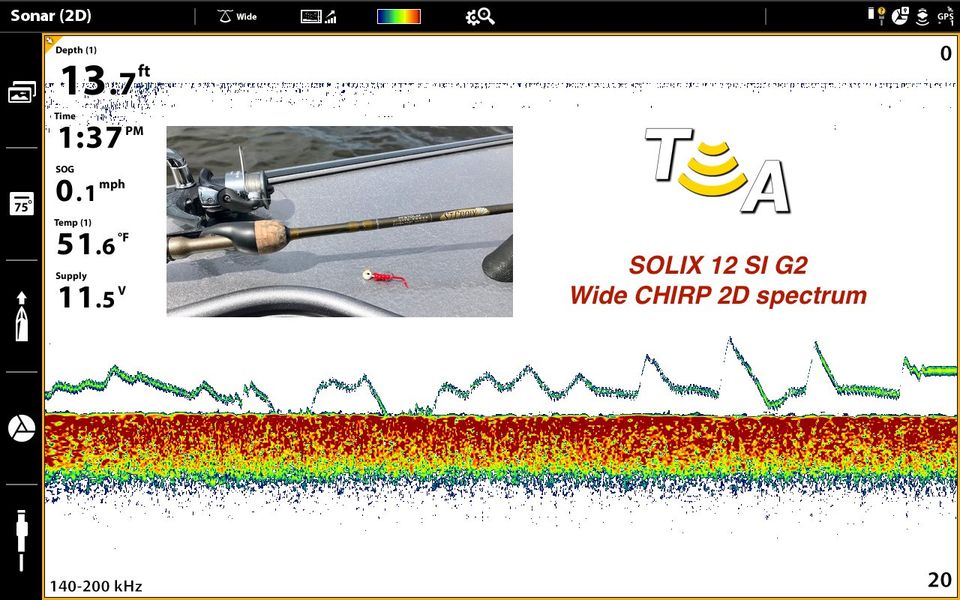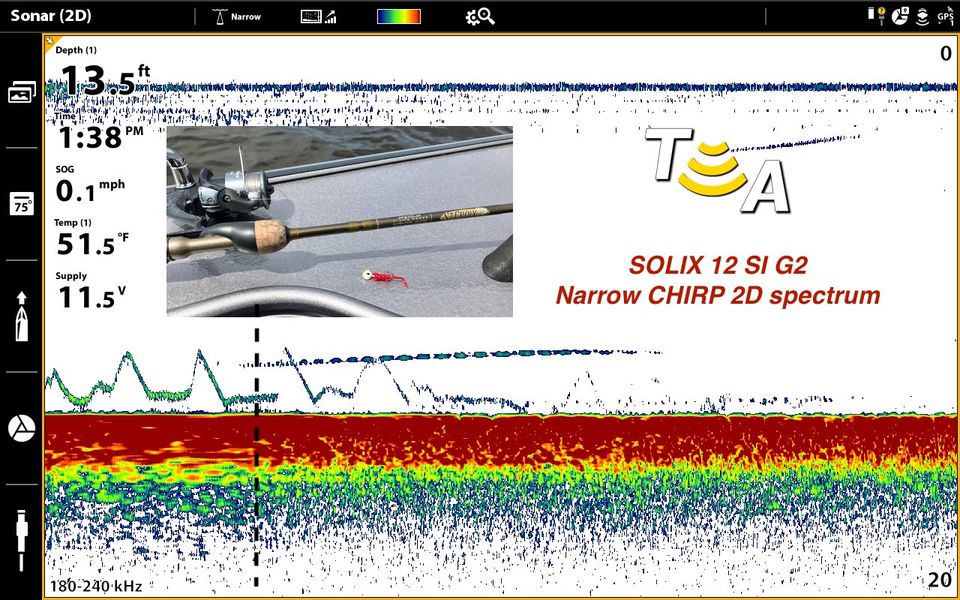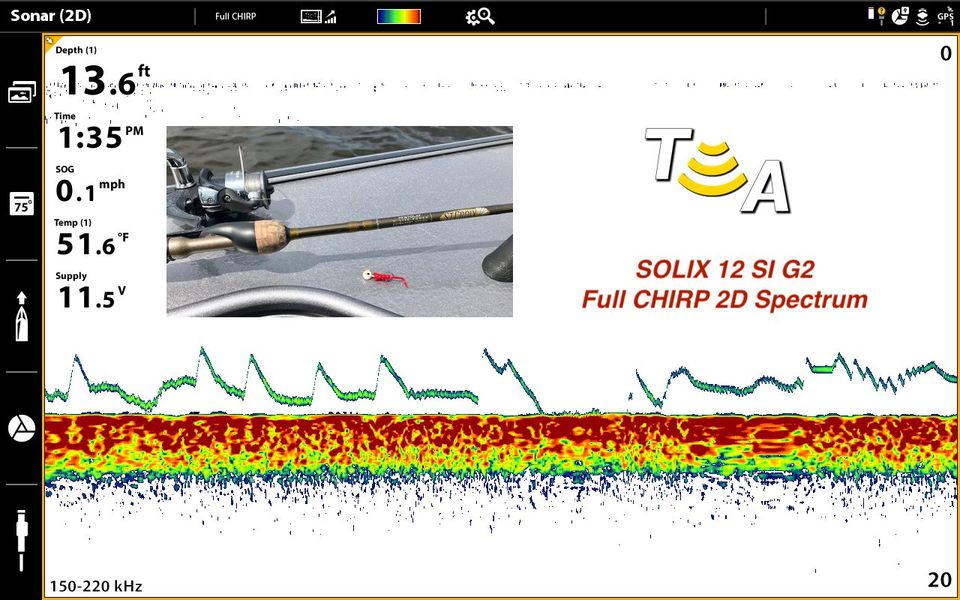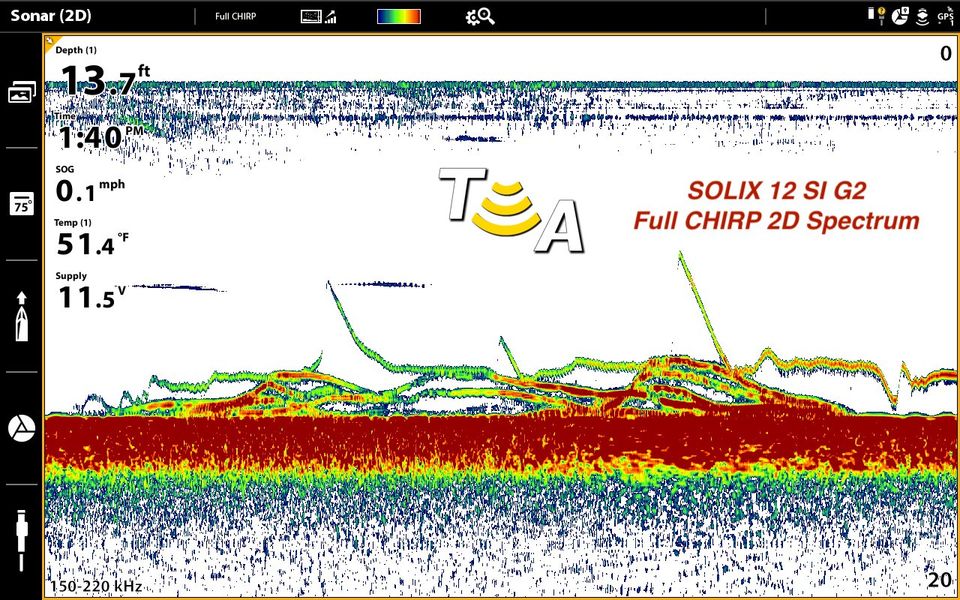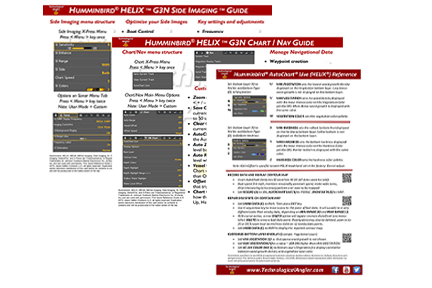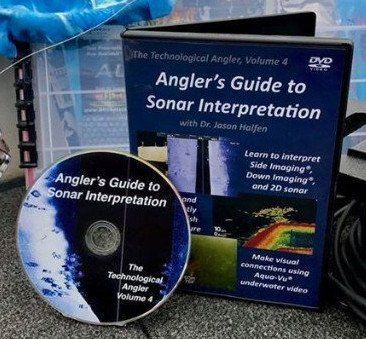Sonar frequencies for vertical jigging
Vertical jigging is one the most common and productive ways to present baits and lures to bottom-oriented fish. A strictly vertical presentation, one in which the lure is able to remain near or within the traditional 2D sonar beam, allows anglers to monitor their lure, and the fish reacting to it, in real time.
Humminbird's new low-Q, true-CHIRP transducers provide anglers with exceptional 2D sonar performance, especially with respect to clarity, detail, and target separation. These transducers provide users with three different 2D sonar frequency ranges to transmit and display:
Narrow
180-240 kHz
25 degree cone angle
Wide
140-200 kHz
42 degree cone angle
Full
150-220 kHz
The Narrow CHIRP spectrum is designed for high-resolution work. Its compact cone angle provides coverage of the bottom and the water column equivalent to 0.47 x water depth, which is more coverage than is provided by the old benchmark 200 kHz frequency's 20 degree cone angle (0.33 x water depth). Notice also that Narrow transmits a frequency spectrum at the higher end of the 2D sonar frequency range. Resolution, or target separation, increases as sonar frequency increases, so it is to be expected that the Narrow CHIRP frequency range should provide the best 2D sonar resolution.
The Wide CHIRP spectrum is designed for greater coverage of the water column and the bottom. Its more expansive cone angle provides coverage of the bottom and the water column equivalent to 0.90 x water depth, which is a little less coverage than is provided by the old benchmark 83 kHz frequency's 60 degree cone angle (~ 1.0 x water depth). Notice also that Wide transmits a frequency spectrum at the lower end of the 2D sonar frequency range. Because resolution, or target separation, increases as sonar frequency increases, it can be expected that the Wide CHIRP frequency range should provide lower resolution 2D sonar views.
The Full CHIRP spectrum is the only user-adjustable frequency spectrum. The default Full CHIRP range is 150-220 kHz, but users can open this up to 140-240 kHz. The Full spectrum option is designed to provide users with the "best of both worlds", coupling the broad coverage of Wide with higher resolution returns from Narrow.
In this article, we explore the utility of each of the three 2D CHIRP sonar settings for vertical jigging. For this initial study, we elected to focus on water that is less than 15 feet deep (which we would consider to be shallow water), and to use a dainty sonar target, something that might be on the small side for most vertical jigging applications: a 1/16 oz VMC Mooneye jig dressed with a 1.5" soft plastic. This was presented on a St. Croix Panfish Series rod (PFS70LXF) rigged with a 1000-series Shimano spinning reel, which was spooled with Seaguar Smackdown braid (20 lb test, 6 lb diameter) in the Stealth Grey color. The selection of a relatively compact sonar target is based on this simple reasoning: if we can see something small, it should be easy to see a more "traditonal" size target, like a heavier jig adorned with a minnow, or a drop shot rig dressed with a larger soft plastic.
In performing these tests, the only setting we changed was the 2D CHIRP frequency range (Narrow/Wide/Full); all of the other common 2D sonar settings (sensitivity, contrast, 2D SwitchFire, Surface Clutter, Chart Speed) were held constant, so the images below reflect only the impact of the frequency selection.
Hardware for the test images was a SOLIX SI G2 unit with our standard three transducer configuration - a left SI transducer, a right SI transducer, and a dedicated 2D skimmer - all interfaced to the SOLIX unit with SIDB and SILR splitter cables. All of the hardware is off-the-shelf with no special modifications. We are also running the latest SOLIX software, which currently is 3.400. With that said, bring on the results!
The Wide spectrum option has no issues tracking the small jig/plastic combo in this relatively shallow water, even with a mid-range 2D sensitivity of 12 in SwitchFire Clear mode. The jig never disappeared from the view - which is expected - as the coverage of the Wide spectrum at this depth is approximately 12 feet wide, which is wider than my Lund Pro-V 1975. The lesson here: keep the jig somewhere beneath the back half of the boat, and you'll be able to see it with the Wide spectrum. I will note that the somar return itself is a little on the noisy/grainy side; I suspect that this is because the 2D beam's transmit power is spread over a wide area, meaning less sonar energy actually reflects off the target, leaving an even smaller amount of sonar energy to travel back to the transducer - hence the noisy return.
The above image shows lure tracking using the Narrow spectrum; the switch from Wide to Narrow was made at the time indicated by the dashed vertical line on the left side of the image. Note that almost immediately after the frequency change, the lure starts to fade from the image. This is almost certainly due to the fact that the lure is on the edge of the Narrow beam's coverage area. It's a challenge to remain perfectly vertical with such a small, light target in real world conditions, with some wind and wave action. The Narrow beam likely has applicability in deeper water, but in this shallow water with a small target, it does not perform well.
The sonar view is excellent in all respects when using the Full CHIRP 2D spectrum. Obviously, lure tracking is flawless, whether the jig is stationary or in motion. Also notice that the noise or grainy appearance of the return that was observed with the Wide spectrum has been eliminated, presumably because the image also includes input from the higher frequency (and higher resolution) portion of the 2D spectrum. In this shallow water application, the Full CHIRP spectrum is the winner for lure tracking while vertical jigging.
How does the Full CHIRP 2D spectrum perform when there are other targets in view, like fish? Well, I admit that it performed much better than did the angler. No trouble seeing the fish ( I would count 4 well-resolved fish targets) as they respond to the lure - the only problem was that they could not be induced to bite. Just because you can see them, doesn't necessarily mean that you can always catch them!
So, the next time you're vertical jigging in relatively shallow water, and want to track your lure and the fish relating to it, give the Full CHIRP 2D spectrum a try. I think you'll be impressed with the results!
LEARN MORE FROM THE TECHNOLOGICAL ANGLER


